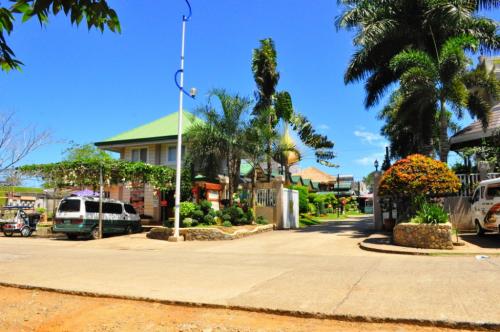Olongapo
World Peace Memorial is located in Olongapo City, Zambales, Philippines. At the entry point to Olongapo City stands a dove as a sign of peace, in memory of those who fought for battle in the Zigzag Pass. The battle is said to be one of the longest and most hazardous battles during World War II. Source:1stphilippines.com
Janiuay
Built by the Japanese forces during the war, the pillboxes rise on both ends of Janiuay Bridge on the way to Lambunao. One is about 25 ft. tall with a diameter of 9 feet. Both pillboxes are intact. These were manned by Japanese soldiers who were later flushed out by Filipino Guerillas. Read more about these World War II Cooncrete Pillboxes. Source:The Official Online Home of Janiuay
Bagac
World War II Markers is located in Bagac, Bataan, Philippines. Bataan is an important historical site of World War II. The region saw an aggressive Japanese invasion and valiant defense by Philippine and American troops until the tragic Fall of Bataan in April 1942. There are a many important historical sites, known as markers, related to memories of World War II. Source:Hoparound.net Wowphilippines.com.ph
Baguio
Wright Park is located in Baguio City, Philippines. It is sometimes mistakenly called "Ride Park" by some who identify this pine tree park reserve for its kiddy horse rides. A long stairway leads to the "Pool of the Pines", a 100 meter long pool of water lined on both sides by the famous Baguio towering pine. Source:Baguio.gov.ph
Island Garden City of Samal
Xtreme Samal is intended for adventure seekers. The place has a unique twist to those already used to riding the zipline. The zipline starts atop a cliff facing the sea then plunges down into the deep water below. If you want a slower descent, you can try rapelling down the wall of the cliff. On the other hand, those who cannot withstand the rush can just sit back and enjoy the view of the Davao Gulf and the facing shoreline of Davao City. HOW TO GET THERE Xteme Samal is located in Kaputian, Island Garden City of Samal. Kaputian is accessible by sea trip from a port in Davao City near Ramon Magsaysay Park. The personnel must be contacted at least a week prior to the intended date of visit. Michael Murrell: 09153730590Marissa: 09293771313 Source:stream of consciousness
Sibulan
Every last Sunday of April | Sibulan The festival is based on the spawning ritual performed by thousands of land crabs such as the cagang and alalasan along the shores and riverbanks of Barangay Cangmating during the last quarter of the year. With the beat of the drums, the performers mimic the land crabs' characteristics through a dance in a pageantry of colorful costumes. Source:Official Website of Sibulan
Zamboanga City
A visit to Zamboanga City is never complete without a stop at the Yakan Weaving Center. Located just across the La Vista de Mar beach resort, the center is where you can find the Yakan people weaving colorful fabrics, clothes, placemats, and other hand-made decors. Source: Wikipedia.org Byahilo.com
Capoocan
Yamashita Lines is located in Capoocan-Kananga, Leyte, Philippines. The Yamashita Lines follow a 50-kilometers stretch along the national highway extending from the Puntapina of the Capoocan-Kananga boundary in the north, over the mountain in the east, through the heart of Ormoc and down to the Palanas river of Albuera in the south. It is also known as the Ormoc Corridor during the Japanese invasion. It was in this line where the bloodiest struggle for the liberation of Leyte took place in 1944. Every year since the early 50s, Japanese pilgrims, World War II veterans, tourists, Comrade-in-arms and kins of Japanese soldiers come to Ormoc to visit this famous war theater where the proud Japanese soldiers suffered their most humiliating debacle. Source:Philtravelcenter.com
Cebu City
The Yap-Sandiego ancestral house located at 155-Lopez Jaena corner Mabini streets in Cebu’s Parian is reputed to be the oldest residential house in the Philippines. The house was built during the late 18th century and owned by Chinese merchants, Juan Yap and his wife Maria Florida with their three children. The Yap-San Diego Ancentral House is also known as Bahay na Bato which means "A house made of stone." Truly, the house was made out of coral stones and egg white was used to let the coral stones stick with each other. The house was once used as a boarding house for students studying at nearby universities but when Mr. and Mrs. Sandiego acquired the ownership, the house was brought back to its original state of interiors. At present, the house functions as a lifestyle museum depicting the kind of living of the Spanish era. The house features antique furnishings made of wood, religious icons, statues etc. Outside the house, there are a couple of wonderful features - a must see for visitors. There is the 15-feet-deep well, used as the source of water centuries ago and the Spanish boat displayed outside facing the garden. Throughout the years, it's amazing how The Yap-San Diego Ancestral house was able to withstand several calamities that hit Cebu. it is indeed a treasure, a Cebuano heritage worth visiting. Source: TavelGrove
Antipolo
Ynares Center is located at Antipolo, Rizal, Philippines. Antipolo is really proud of this 350 million peso state-of-the-art coliseum which is considered as a landmark of the city. The Center can hold PBA games, motor racing, and music concerts. Source:PeopleEventsplaces.com
